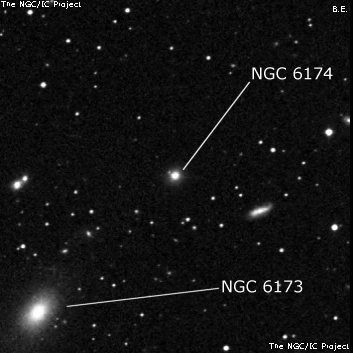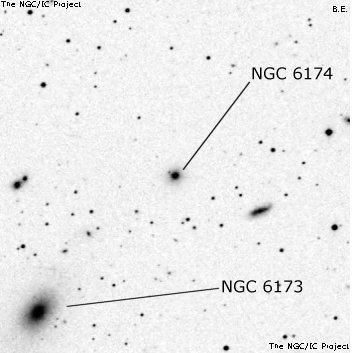NGC/IC Project Restoration Effort
(This is a very very beta version)
NGC6174


Basic Information
Location and Magnitude
Right Ascension: 16:29:23.8
Declination: +40:52:30
Constellation: HER
Visual Magnitude: 14.0
Historic Information
Discoverer: Stoney J.
Year of discovery: 1849
Discovery aperture: 72.0
Observational
Summary description: vF
Sub-type: E-S0
Corwin's Notes
=====
NGC 6174 is one of three nebulae found by Johnstone Stoney in 1849 while he
was observing NGC 6173 (h 1962 = H III 640), and is the only one of the three
included in the GC and NGC. JH took the observation from LdR's 1861 paper
which lists only the three nebulae in the area found by JH, plus a terse
comment "Another nearby." LdR's 1880 monograph has a fuller description of
the observations, as well as a sketch of three of the nebulae. While the
sketch is not labeled, it is clear from the descriptions that the one shown in
the upper left is NGC 6173. A double nebula is directly north at a distance,
estimated in the sketch, of 6 arcmin; while the third is an estimated 8 arcmin
"east" of the second.
The direction "east" is in quotes since the diagram does not fit the sky
unless Stoney (or Dreyer, who prepared the monograph) got the direction wrong.
Normally, the arrows in the diagrams point to the east; in this case, it must
be west. Bindon Stoney made another observation and sketch in 1851 which
confirms the three sketched by his brother in 1849. The 1851 sketch is not
reproduced in the 1880 monograph, presumably because it shows the same three
nebulae.
The fourth nebula, noted only in J. Stoney's 1849 observation, comes from this
comment: "About 15 arcmin following and 3 arcmin north of this [N6173] there
is a new neb, vF, gbM." There are no galaxies in that location that might
have been seen with even the 72-inch Leviathan -- but there is one 15 arcmin
preceding and 3 arcmin north that fits this description. This is another
indication that the east/west directions in this 1849 observation have been
reversed.
Dreyer added a note to the NGC for NGC 6174: "Second of 3, forming a
rectangular triangle, the 2 others being assumed to be h1962 [N6173] and h1963
[N6175], but the identity of the group is doubtful." Dreyer's note is
incorrect in making two of the nebulae identical to JH's; only one, N6173, is
(N6175 is 11 arcmin south; see the next paragraph). The other two in the
sketch are "novae."
The final 72-inch observation from 18 May 1860 by S. Hunter suggests that he
saw N6175 ("... an E neb, with a * close to f end, and either a knot or a * in
p end"), and then concludes, "Found no other nebulae near. Twilight
troublesome." Perhaps the last two words explain the lack of additional
nebulae, since N6175 is in the midst of a cloud of rather faint galaxies in
the outskirts of Abell 2199.
So, we have a problem: three new nebulae found at Birr, but only one NGC
number for them. Several sources have taken the double nebula north of N6173
as N6174. I am a little reluctant to do this as Dreyer called N6174 only "vF"
making no mention of the duplicity. On the other hand, this one fits the NGC
position best -- assuming the east-west switch -- and was sketched twice.
So that leaves two galaxies here seen by the Stoneys with no NGC numbers. See
the "notngc" files for a bit more information on these.
Steve's Notes
=====
NGC 6174
18" (7/29/08): faint, small, slightly elongated, 20" diameter. Appears to have an extremely faint star involved. This is a double system (IV Zw 63) with a nearly stellar companion on the northwest side, and the "star" I noted is a compact galaxy (PGC 58350).
CGCG 224-047 = PGC 58334 lies 4.5' W. This galaxy was also discovered and sketched in the Birr Castle observation and Harold Corwin favors it as NGC 6174. CGCG 224-047 appeared faint, small, round, 25" diameter, even surface brightness. MCG +07-34-081 = PGC 58321 lies 2.5' further southwest and appeared faint, small, round, 20" diameter, low even surface brightness.
17.5" (7/5/86): very faint, small, slightly elongated, requires averted vision. Located 3.5' N of NGC 6173 in AGC 2197. This is a double system (unresolved).



